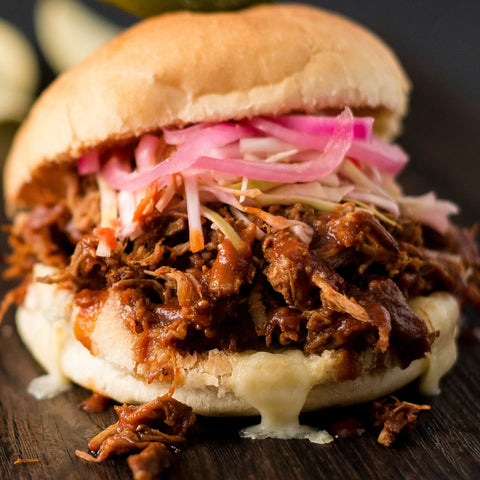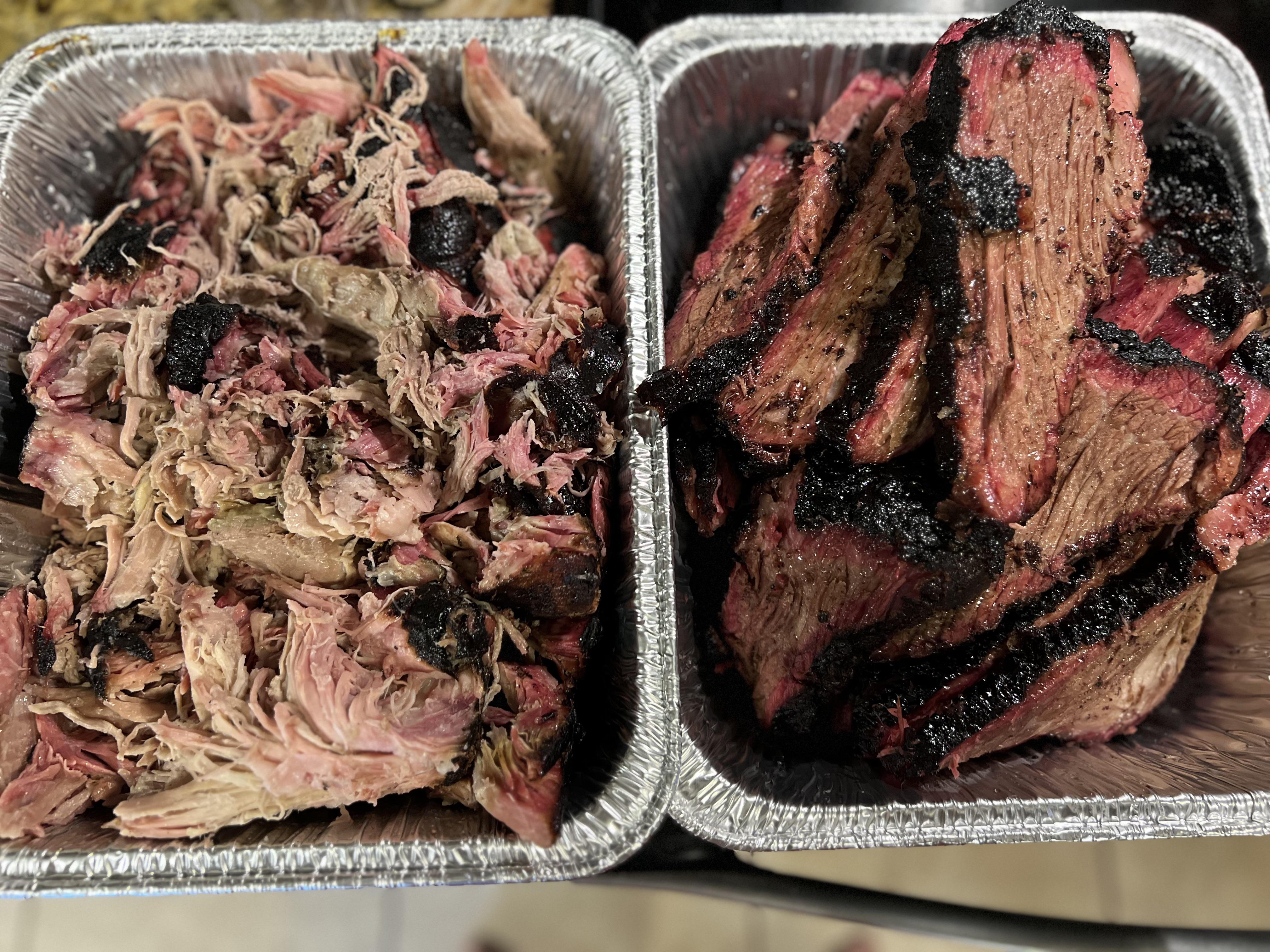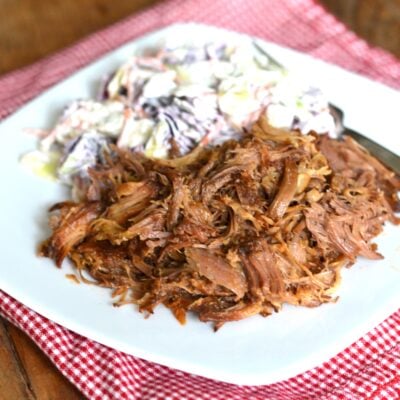Overview Of Brisket And Pulled Pork

Brisket and pulled pork are both popular choices when it comes to BBQ favorites. Brisket is a cut of beef, while pulled pork is made from pork. These meats have distinct flavors and textures that appeal to different palates. Brisket is known for its rich, smoky taste and tender, melt-in-your-mouth texture. Pulled pork, on the other hand, is known for its juicy and flavorful meat that falls apart easily. Both meats require different cooking methods and techniques to achieve their desired tenderness. When it comes to choosing between brisket and pulled pork, personal preferences and dietary restrictions should be considered.
Introduction To Brisket And Pulled Pork
Brisket and pulled pork are two beloved BBQ favorites that offer distinct flavors and textures. Brisket is a cut of beef known for its rich, smoky taste and tender, melt-in-your-mouth texture. It requires slow cooking over a long period of time to achieve its desired tenderness. Pulled pork, on the other hand, is made from pork and is known for its juicy and flavorful meat that falls apart easily. It is typically cooked low and slow, resulting in a tender and succulent texture. These two meats have their own unique appeal and are often enjoyed at BBQ gatherings and cookouts.
Key Differences In Cooking Methods
The key differences in cooking methods between brisket and pulled pork lie in the time and temperature required to achieve optimal results. Brisket requires slow cooking over a long period of time, typically around 10-12 hours, at a low temperature of around 225-250°F (107-121°C). This slow and low method allows the connective tissues in the brisket to break down, resulting in tender, melt-in-your-mouth meat.
On the other hand, pulled pork is also cooked low and slow, but for a longer period of time, usually 12-14 hours. The cooking temperature for pulled pork is slightly higher, around 250-275°F (121-135°C), which allows the pork to become tender and easily pull apart.
These different cooking methods contribute to the distinct flavors and textures of each meat, making them unique and delicious in their own right.
Brisket Flavor Profile And Preparation

Brisket is famous for its distinct flavor profile and requires specific preparation to achieve its tender and flavorful results. The flavor of brisket is rich and beefy, with a smoky undertone from the slow cooking process. To prepare brisket, it is often seasoned with a dry rub and then slow-cooked for hours, allowing the flavors to penetrate the meat. The slow cooking at low temperatures breaks down the tough connective tissues, resulting in a melt-in-your-mouth texture. Brisket can be smoked or cooked in the oven, but the key is to give it plenty of time to develop its unique flavor and tenderness.
Brisket Taste And Texture
Brisket is known for its bold, savory flavor and melt-in-your-mouth texture. The slow cooking process allows the flavors to penetrate the meat, resulting in a rich and beefy taste. The outer layer develops a crispy bark, adding a delightful smokiness. As for the texture, properly cooked brisket should be moist and tender, with the connective tissues broken down to create a succulent bite. The combination of the savory flavor and tender texture makes brisket a favorite among barbecue enthusiasts.
Brisket Smoking Techniques
When it comes to smoking brisket, there are a few key techniques to ensure a delicious and tender result. First, it’s important to prepare the brisket by trimming excess fat and applying a flavorful rub. The smoking process typically involves using a smoker or grill set to a low temperature (between 225-275°F) and using wood chips or chunks for a smoky flavor. The brisket is then placed on the smoker and cooked slowly for several hours until it reaches an internal temperature of around 195-205°F. This slow and low cooking method allows the flavors to develop and the connective tissues in the meat to break down, resulting in a melt-in-your-mouth texture.
Pulled Pork Flavor Profile And Preparation

Pulled pork has a distinct flavor profile that sets it apart from other meats. The long, slow cooking process results in tender, juicy meat with a smoky and savory taste. The pork is typically seasoned with a dry rub or marinated in a flavorful mixture before being slow-cooked until it reaches a pull-apart texture. The flavor of pulled pork is often described as sweet, tangy, and slightly spicy, thanks to the combination of spices and the use of barbecue sauce. It pairs perfectly with tangy coleslaw and soft buns, making it a crowd-pleasing favorite for barbecue enthusiasts.
Pulled Pork Taste And Tenderness
Pulled pork has a distinct and mouth-watering taste that is sweet, tangy, and slightly spicy. The long, slow cooking process allows the flavors from the marinade or dry rub to penetrate the meat, resulting in a deliciously tender and juicy texture. The meat should be so tender that it easily pulls apart with a fork. The combination of flavors and the melt-in-your-mouth tenderness is what makes pulled pork so popular and irresistible. It is the perfect choice for barbecue lovers looking for a flavorful and tender meat dish.
Best Cuts For Pulled Pork
When it comes to making pulled pork, the best cut of meat to use is the pork shoulder, also known as the pork butt or Boston butt. This cut is marbled with fat, which adds flavor and helps keep the meat moist during the slow cooking process. The pork shoulder is a tough cut of meat that benefits from the long, slow cooking time, which breaks down the connective tissue and allows the meat to become tender and easy to pull apart. Other cuts, such as the picnic shoulder or pork loin, can be used for pulled pork, but they may not have the same level of tenderness and flavor as the pork shoulder. So, for the juiciest and most flavorful pulled pork, choose the pork shoulder as your cut of choice.
Brisket Vs Pulled Pork: Nutritional Comparison

When comparing the nutritional values of brisket and pulled pork, it is important to note that both meats are rich in protein. However, brisket is considered to be slightly healthier than pulled pork due to its lower fat content. Brisket contains less fat and calories compared to pulled pork, making it a better option for those who are mindful of their fat intake. Both meats offer similar levels of sodium and other nutritional values. Overall, there is not a significant difference in terms of health benefits between brisket and pulled pork.
Calorie And Fat Content In Brisket And Pulled Pork
When comparing the calorie and fat content of brisket and pulled pork, it is important to note that there are slight differences. In a 100-gram serving, brisket has approximately 157 calories and 7.37 grams of fat, while pulled pork has around 242 calories and 13.92 grams of fat. This means that pulled pork has slightly higher calorie and fat content compared to brisket. Therefore, if you are watching your calorie and fat intake, opting for brisket may be a better choice.
Protein Levels In Brisket And Pulled Pork
When it comes to protein levels, both brisket and pulled pork offer a good amount for those looking to fuel their bodies. However, brisket tends to have slightly higher protein content compared to pulled pork. In a 100-gram serving, brisket contains around 24 grams of protein, while pulled pork has approximately 22 grams. Protein is crucial for muscle repair and growth, making both brisket and pulled pork excellent options for those looking to meet their protein needs. Whether you choose brisket or pulled pork, you’ll be getting a satisfying dose of protein for a BBQ favorite.
Serving Ideas And Popular Recipes

When it comes to serving ideas for brisket and pulled pork, the possibilities are endless. Here are a few creative ideas to inspire your next BBQ feast:
- Brisket Tacos: Slice the brisket thinly and serve it in warm tortillas with your favorite taco toppings like salsa, guacamole, and cilantro.
- Pulled Pork Sliders: Serve pulled pork on mini slider buns with coleslaw for a delicious handheld treat.
- Brisket Nachos: Top tortilla chips with shredded brisket, melted cheese, jalapenos, and sour cream for a crowd-pleasing appetizer.
- Pulled Pork Pizza: Spread BBQ sauce on a pizza crust, top it with pulled pork, red onions, and cheese for a mouthwatering twist on pizza.
- Brisket Chili: Add diced brisket to your favorite chili recipe for a meaty and flavorful twist.
Popular Recipes:
- Smoked Brisket: Rub the brisket with a blend of spices, smoke it low and slow for several hours until it’s tender and delicious.
- Slow Cooker Pulled Pork: Season the pork shoulder with your favorite dry rub, slow cook it until it’s fork-tender, then shred and mix with BBQ sauce.
No matter which serving idea or recipe you choose, both brisket and pulled pork are sure to be a hit at your next BBQ gathering. Enjoy!
Creative Ways To Serve Brisket And Pulled Pork
There are countless creative ways to serve both brisket and pulled pork that will impress your guests and elevate your BBQ experience. Here are some ideas to spark your culinary creativity:
- Brisket Tacos: Slice the tender brisket thinly and serve it in warm tortillas with your favorite taco toppings like salsa, guacamole, and cilantro.
- Pulled Pork Sliders: Serve pulled pork on mini slider buns with a dollop of coleslaw for a mouthwatering handheld treat.
- Brisket Nachos: Top tortilla chips with shredded brisket, melted cheese, jalapenos, and sour cream for a crowd-pleasing appetizer.
- Pulled Pork Pizza: Spread BBQ sauce on a pizza crust, top it with pulled pork, red onions, and cheese for a delicious twist on pizza.
- Brisket Chili: Add diced brisket to your favorite chili recipe for a meaty and flavorful twist.
These serving ideas provide a variety of ways to enjoy the smoky and savory flavors of both brisket and pulled pork. Let your imagination run wild and create your own unique combinations!
Favorite BBQ Sauces And Toppings
When it comes to BBQ, the sauce and toppings play a crucial role in enhancing the flavors of both brisket and pulled pork. Some favorite BBQ sauces include tangy vinegar-based sauces, sweet and smoky tomato-based sauces, and spicy dry rubs. Toppings like coleslaw, pickles, and onions add a refreshing crunch to the rich and tender meat. Additionally, serving the meat with cornbread, baked beans, or macaroni and cheese can elevate your BBQ experience to the next level. Experiment with different combinations to find your own favorite combination of sauces and toppings.
Conclusion

In conclusion, the choice between brisket and pulled pork ultimately comes down to personal preference and the occasion. Brisket offers a rich and indulgent flavor with a firm texture, making it a hearty option for special gatherings. On the other hand, pulled pork provides tender, melt-in-your-mouth goodness that is perfect for casual BBQ parties. Both meats can be enjoyed with a variety of sauces and toppings, allowing you to customize your meal to your liking. Whichever option you choose, you can’t go wrong with these BBQ favorites. So fire up the grill and savor the deliciousness of brisket or pulled pork!
Pros And Cons Of Brisket And Pulled Pork
When it comes to the pros and cons of Brisket and Pulled Pork, there are a few key points to consider.
Pros of Brisket:
- Rich and indulgent flavor
- Firm texture that holds up well in sandwiches and tacos
- Impressive presentation for special gatherings
Cons of Brisket:
- Longer cooking time (up to 12 hours) due to its size
- Requires more skill and attention to achieve tender results
- Higher price point compared to pulled pork
Pros of Pulled Pork:
- Tender and melt-in-your-mouth goodness
- Versatility in various dishes like sliders, nachos, and BBQ pizzas
- Easier to cook and more forgiving for beginners
Cons of Pulled Pork:
- Can be overly fatty if not trimmed properly
- Slightly less impressive presentation compared to whole brisket
- Limited texture variety compared to the different cuts of brisket
Ultimately, the choice between brisket and pulled pork depends on personal preference, cooking skill, and the occasion at hand.
Personal Preferences And Final Thoughts
When it comes to personal preferences in the brisket vs pulled pork debate, it ultimately comes down to individual taste. Some may prefer the rich and indulgent flavor of brisket, while others may opt for the melt-in-your-mouth tenderness of pulled pork. It’s important to consider the occasion and cooking skill as well. Brisket may be more suitable for special gatherings and requires more attention to achieve tender results. On the other hand, pulled pork is versatile and forgiving for beginners. Ultimately, both brisket and pulled pork have their own unique qualities that make them BBQ favorites.
FAQ section comparing brisket and pulled pork:
| Brisket vs Pulled Pork |
|---|
| Q: What is the main difference between brisket and pulled pork? |
| A: The main difference lies in the cut of meat used. Brisket comes from the lower chest of the cow, while pulled pork is typically made from pork shoulder or pork butt. |
| Q: Which meat takes longer to cook – brisket or pulled pork? |
| A: Brisket usually takes longer to cook compared to pulled pork. It requires low and slow cooking to break down the tough connective tissues and become tender, often taking up to 12-16 hours. Pulled pork, on the other hand, can be cooked in 8-10 hours. |
| Q: Which meat is more flavorful – brisket or pulled pork? |
| A: Both brisket and pulled pork are known for their distinct flavors, but some may argue that brisket has a richer, beefy flavor, while pulled pork tends to be juicier and has a more pronounced smoky flavor. It ultimately comes down to personal preference. |
| Q: Are there any significant differences in preparation methods for brisket and pulled pork? |
| A: Yes, the two meats require different preparation methods. Brisket is typically seasoned with a dry rub and smoked for an extended period, while pulled pork is often marinated in a wet rub or brine before being slow-cooked and shredded. |
| Q: Which meat is more versatile in terms of serving options – brisket or pulled pork? |
| A: Both brisket and pulled pork are versatile meats that can be enjoyed in various ways. Brisket is often sliced and served as the main dish, while pulled pork is commonly used in sandwiches, sliders, tacos, and bowls. |
| Q: Is one meat considered healthier than the other – brisket or pulled pork? |
| A: In terms of health considerations, pulled pork is typically leaner than brisket, which contains more fat. However, the healthiness of either meat can vary based on the cooking methods and ingredients used. |
These FAQs should provide a good overview of the key differences and considerations when comparing brisket and pulled pork.

Halal Meat Bazar is a leading provider of HMC-approved quality halal meat, offering competitive prices and exceptional services. With a commitment to excellence, we cater to both wholesale and retail customers, ensuring that everyone has access to premium halal meat products. Our journey began with a passion for providing the finest quality halal meat to the community. Founded on the principles of integrity and quality, Halal Meat Bazar has consistently upheld the highest standards in sourcing, processing, and delivering halal meat products. Our dedication to maintaining the authenticity of halal meat has earned us the trust and loyalty of our customers.